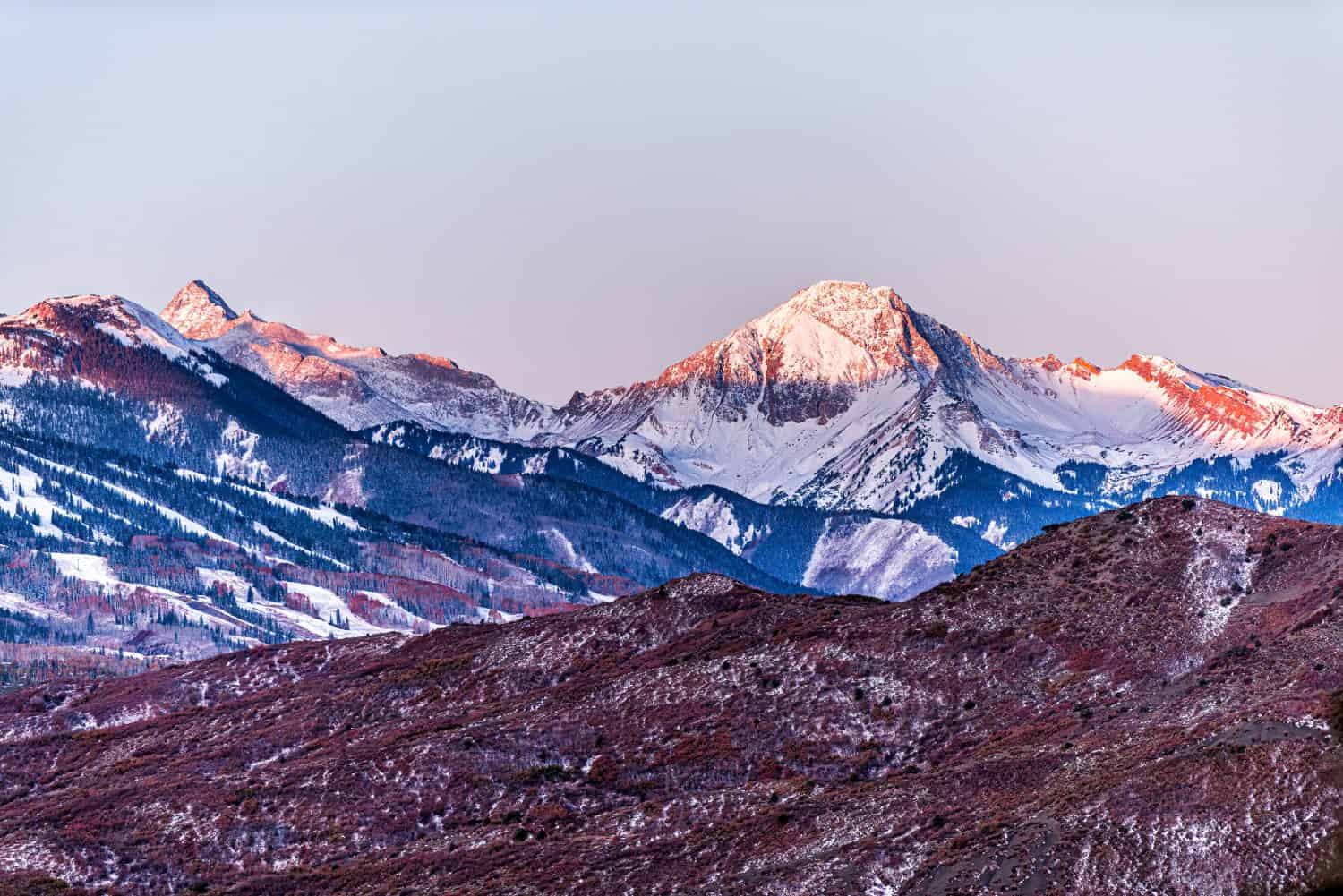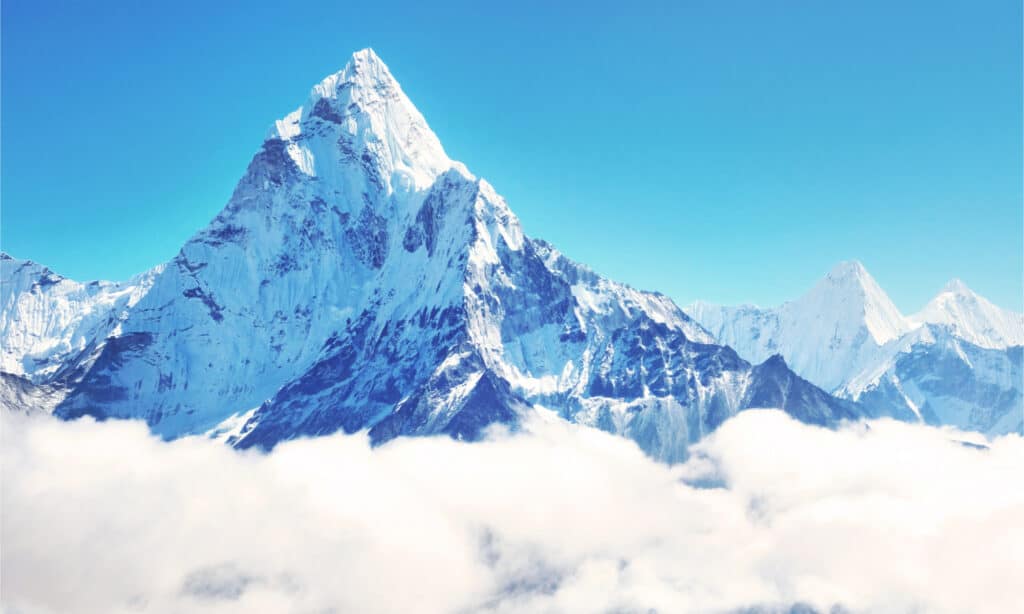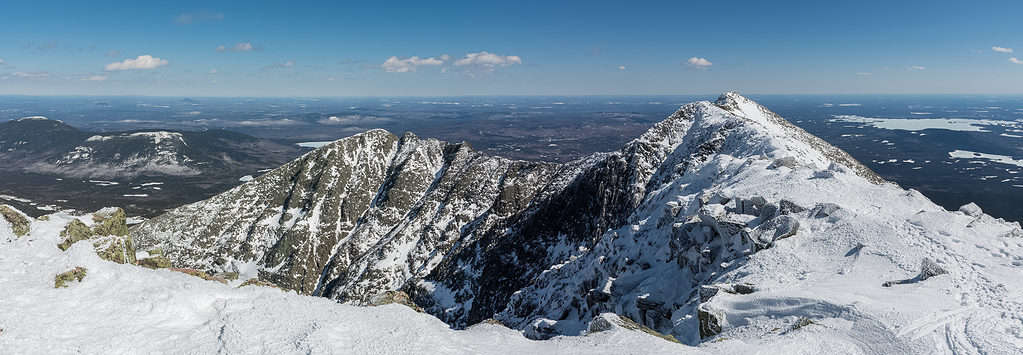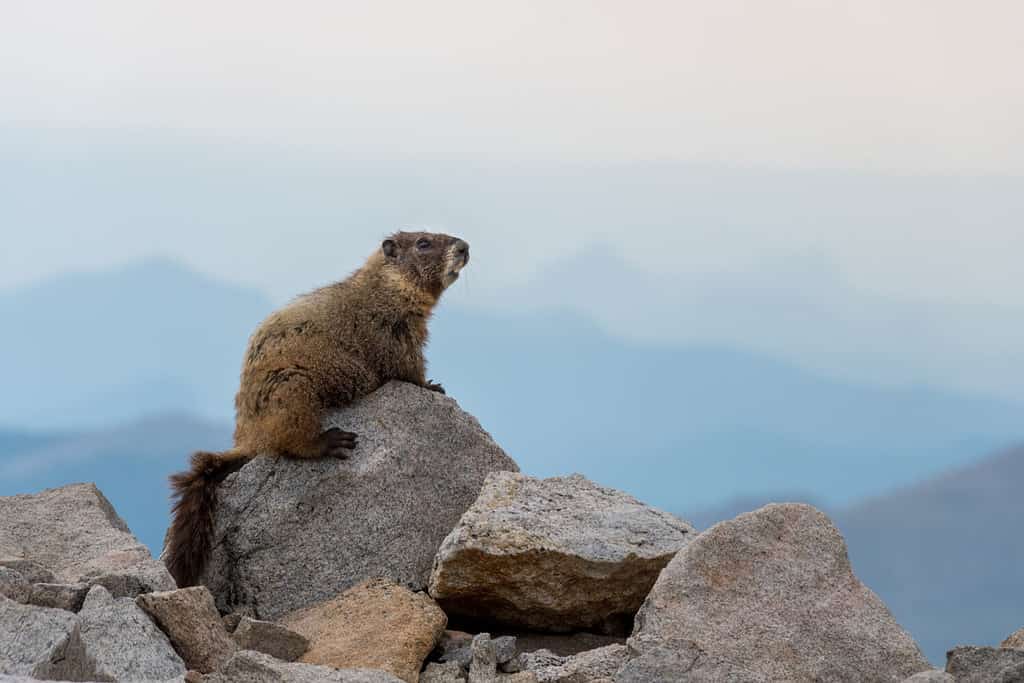Capitol Peak in Colorado is famed for Knife’s Edge and its ultra-challenging terrain. It’s a soaring peak for sure and one of the State’s most epic 14ers, so let’s discover just how tall Colorado’s Capitol Peak really is, what’s prowling around up there, and where exactly you can find it.
How Tall Is Capitol Peak in Colorado?
Capitol Peak in Colorado is 14,137 feet (4,309 meters) tall. Its lofty elevation makes it the 52nd tallest mountain in North America.

Colorado’s Capitol Peak is 14,137 feet tall.
©Andriy Blokhin/Shutterstock.com
Where Is Capitol Peak?
Capitol Peak sits in the Elk Mountains range of The Rockies, just 14 miles west of Aspen.
More precisely, it’s in the Maroon Bells-Snowmass Wilderness of White River National Forest. The highest peak sits on a ridge running from the Elk Mountains northwards to Mount Sopris.
This rugged and remote peak is quite possibly the most difficult 14er in Colorado, which is saying something because Colorado is famous for its elevation. Out of the United States‘ 96 14ers, Colorado has over 50!
Experienced hikers and rock climbers add this to their bucket list, and many never tick it off because it’s just such a challenge. Steep and treacherous terrain means hand and foot holds on a regular basis, and often ropes, too.
How Was It Formed?
Intense tectonic activity formed western North America’s Rocky Mountains between 80 to 35 million years ago. Experts named this period the Laramide orogeny.
After the mountain building, volcanoes, mudflows, and falling ash shaped the landscape. But it doesn’t stop there. Two major glacial events created gouges and lakes over 300,000 and 30,00-12,000 years ago.
So, Capitol Peak pushed up from the Earth’s crust millions of years ago, and then volcanos and glacial events weathered it. Of course, eroding weather events still change their face today. Ancient Capitol Peak didn’t look like the peak that inspired the 1874’s Hayden Survey to name it after Washington DC’s Capitol Building.
Nearby Peaks
Capitol Peak has many lofty neighbors. 13,304 feet tall Mount Daly lies 1.4 miles away. Snowmass Mountain at 14,075 feet, and 13,619 foot-tall Snowmass Peak all sit within 3.2 miles.
A little further out, at 7.4 miles off, Maroon Bells towers 14,158 feet, and the infamous 14,020-foot-tall Pyramid Peak is just 8.9 miles away.
Capitol Peak certainly has an impressive Coloradoan company!

Snowmass Peak is just over three miles from Capitol Peak.
©iStock.com/nick1803
Capitol Peak Compared to the U.S.
Lofty Capitol Peak rises 14,137 feet tall, but it falls short of North America’s highest peak, Mount Denali in Alaska. Mount Denali looks down on the U.S. from 20,130 feet.
But how does Capitol Peak stack up to the rest of the world’s tallest peaks?
The world’s tallest mountain is Asia’s Mount Everest. This peak dwarfs all others at 29,032 feet.
Here’s how it compares to other continents around the globe:
- South America: Mount Aconcagua 22,837 feet.
- Europe: Mount Elbrus 18, 510 feet.
- Africa: Mount Kilimanjaro 19,341 feet
- Antarctica: Mount Vinson 16,050 feet.
- Australia: Mount Kosciuszko 7,310 feet.

Mount Everest is the highest mountain in the world, at 29,032 feet.
©Vixit/Shutterstock.com
What to Do at Capitol Peak
Colorado’s Capital Peak provides challenging hikes, rock climbing, and camping.
Hikes
Capitol Peak is not a beginner or even a moderate hiker’s destination. In 2017, five climbers died here within six weeks, and one woman died when a rock hold gave way, leading to a 900-foot fall.
The most challenging part is Knife’s Edge, an exposed ledge with loose rocks on the mountainside. Its steepness and exposure make it dangerous even during the summer months.
On the flip side, beautiful mountain lakes and epic scenery make this hike a challenging yet exhilarating hike. Start at Snowmass Village and follow the lightly used trail for 15.1 miles. In good conditions, it can take fit hikers more than 12-13 hours to ascend and descend Capitol Peak. Many plan a two-day round trip.
If the full hike is too intimidating, try the 9,000-foot ascending Daly Pass route. This is the first interest point on the Capitol Peak trail. Its recognizable saddle-shaped pass is filled with interesting wildflowers and a spectacular view of Capitol Peaks’ lofty head.

Knife Edge is the most challenging part of the Capitol Peak hike.
©David Boutin/Shutterstock.com
Camping
Camping facilities on Capitol Peak are primitive, to say the least! There’s a designated site near the trailhead and several near Capitol Lake, but do not expect luxury. Bring everything you need and obtain the required permits in advance.
Rock Climbing
Rock climbers enjoy the solid rock found on Capitol Peak because rocks feel looser on surrounding mountains.
Classic rock climbs here include Grade II Knife Edge on the North East Route and grade IV Capitol Snowmass Traverse, Northwest Buttress, and Early Times.
Wildfire on Capitol Peak
Wildfires occur in the Rocky Mountain range from spring to fall when dry air and strong winds kindle and grow flames. Always check first to keep safe.
What Animals Live on Capitol Peak?
The very top of Colorado’s Capitol Peak is windswept, barren, and often snowy, so other than swooping raptors such as eagles, hawks, ospreys, falcons, kestrels, and vultures very little lives there. However, further down the mountainsides, incredible animals make this challenging terrain their home. Here are just a few of the epic Capitol Peak animals.
Rocky Mountain Elk
Capitol Peak sits in the Elk Mountain range, so it’s no surprise elk live on its slopes. The rocky mountain elk is a subspecies of elk found here.
One of the largest deer family members, bull elks stand five-foot-tall at the shoulder and weigh hundreds of pounds. Their impressive velvety antlers grow an inch per day during spring, then fall off in winter.
Elk graze on vegetation, and the largest individuals have no predators, but mountain lions and coyotes prey on elk calves.

Rocky Mountain elk can weigh hundreds of pounds.
©Virrage Images/Shutterstock.com
Pikas
Cute brown pikas live on mountain slopes and meadows, gathering vegetation, which they eat immediately or cache for winter in burrow larders.
Pikas are related to the rabbit family but look like rodents. Adults reach seven inches long and have padded feet with sharp, curved claws. They help pikas quickly dash about rocky and snowy mountainsides, escaping raptors, mountain lions, and coyote predators.
To warn others in the group of danger, pikas emit a high-pitched squeak. With excellent eyesight and hearing, they’re a hard catch.
Mountain Lion
Mountain lions thrive throughout the Rocky Mountains and Capitol Peak surrounds. They’re the largest predator in the Rocky Mountain National Park, reaching eight feet long and 200 pounds heavy.
Also known as cougars, pumas, or panthers, these epic solitary cats can leap 20 feet in the air and bound 40 feet across mountain rocks with ease to catch bighorn sheep, hares, pikas, or birds.
White-tailed Ptarmigan
North America’s smallest grouse, the white-tailed ptarmigan, turns pure white in winter to blend into its surroundings, then magically develops gray and brown streaks in winter when the snow melts. At only 12 inches long and 11-16 lbs, they’re adept at hiding away in the treeline, where they pick out tasty leaves, buds, fruits, insects, and seeds.
Like most grouse, white-tailed ptarmigans prefer walking than flying, but they take to air when startled. Pairs mate for life, leaving each other after the chick-raising season and meeting up again the following spring.

White-tailed ptarmigans are virtually invisible in snow.
©Carrie Olson/Shutterstock.com
Bighorn Sheep
True to the name, bighorn sheep boast big horns! The largest wild sheep in North America, whopping males, can weigh over 300 pounds and reach three feet at the shoulder. In winter, their coats grow thick, double layers, but when warmer weather approaches, they shed all that excess wool.
With eyes on either side of their heads, bighorn sheep have a wide range of vision to escape mountain lions, coyotes, and wolves. When chased, they use specialized hooves to climb steep cliff faces and jump large gaps to safety.
Marmots
The largest member of the squirrel family, marmots have reddish-brown fur and reach around two feet in length. Chunky, squat, and very loud, these inquisitive creatures live in underground burrows with a colony of 10-12 family members. Young marmots are a source of prey for the Rocky Mountain carnivores, and only half make it to adulthood.

Marmots are the largest member of the squirrel family.
©Eivor Kuchta/Shutterstock.com
Western Diamondback Rattlesnake
Western diamondback rattlesnakes live up to 6,500 feet in the Rocky Mountains. You certainly won’t find them at the vertiginous top of Capitol Peak!
This venomous snake lives in steep rocky canyons and caves, coming out to sun soak and hunt marmots, pikas, and birds.
Their venom is potent, and their specialized fangs are much larger than other rattlesnake species, which means a larger dose of venom. While fatalities are rare, bites require immediate medical attention.
Height of Capitol Peak in Colorado
Let’s recap!
Capitol Peak in Colorado reaches 14,137 feet (4,309 meters) tall. Its lofty elevation makes it the 52nd tallest mountain in North America. Its height, exposure, cliff drops, and heavy snow make it one of the most challenging peaks in the Rocky Mountains.

Capitol Peak was named for its resemblance to Washington DC’s capitol building.
©iStock.com/ChrisBoswell
The photo featured at the top of this post is © David Boutin/Shutterstock.com
Thank you for reading! Have some feedback for us? Contact the AZ Animals editorial team.






